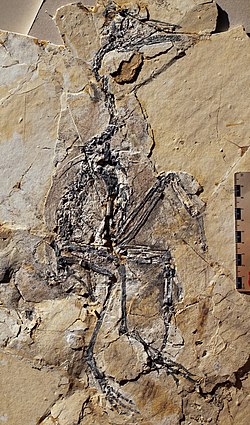Archaeovolans
|
Yanornis Temporal range: Early Cretaceous, 125–120 Ma |
|
|---|---|
 |
|
| Fossil specimen of Y. martini | |
| Scientific classification | |
| Kingdom: | Animalia |
| Phylum: | Chordata |
| Family: | †Songlingornithidae |
| Genus: |
†Yanornis Zhou & Zhang, 2001 |
| Type species | |
|
†Yanornis martini Zhou & Zhang, 2001 |
|
| Species | |
|
|
| Synonyms | |
Yanornis (Chinese: 燕鸟) is an extinct genus of fish-eating Early Cretaceous birds. Two species have been described, both from Liaoning province, China: Yanornis martini, based on several fossils found in the 120-million-year-old Jiufotang Formation at Chaoyang, and Yanornis guozhangi, from the 124-million-year-old Yixian Formation.
Y. martini was the size of a chicken, had a long skull with about 10 teeth in the upper jaw and 20 teeth in the lower jaw, and was both able to fly and walk well, having a well-developed U-shaped furcula (wishbone).
The absence of the prefrontal bone and the non-diapsid skull allows Yanornis to be classified as an ornithuromorph, a member of a group of stem-birds which also includes the common ancestor of living birds. Similarly, its scapula and coracoid had evolved the basic shape and layout as in modern birds, enabling Yanornis to lift its wings far above its back for an efficient upstroke. It was probably a more efficient flyer compared to enantiornithines (which have the modern condition in a less well-developed form), and especially compared to Confuciusornis and Archaeopteryx, which were only marginally able to perform upstrokes. To allow for the necessarily large flight muscles, the sternum of Yanornis was longer than it was wide, again representing an essentially modern condition.
Several fossil specimens of Y. martini preserve the remains of fish in the stomach and crop, suggesting that these birds were primarily fish-eaters. Their fish-eating and associated adaptations show convergent evolution with the unrelated enantiornithine Longipteryx.
...
Wikipedia
